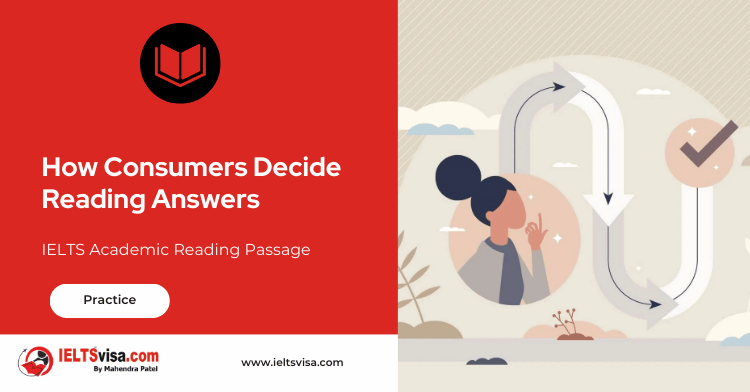How Consumers Decide Reading Answers
IELTS Academic Reading Passage
Questions 1-6
Do the following statements agree with the information given in the Reading Passage?
Write answers in your answer sheet write:
TRUE if the statement agrees with the information
FALSE if the statement contradicts the information
NOT GIVEN if there is no information on this
- Little research has been done on the link between packaging and consumers choosing a product.
- A person who buys what another person recommends is using heuristic thinking.
- Heuristic processing requires more energy than systematic processing.
- The concept of heuristic processing was thought up by Dr Maule’s team.
- A consumer who considers how much a product costs, is using systematic processing.
- For heuristic processing, packaging must be similar to other products.
Questions 7-8
Choose the correct answer A, B, C or D and write the answers in your answer sheet.
7. When trying to determine how effective packaging is, testing can be made ‘ineffective’ if
A. you rely upon a very narrow focus group.
B. your consumers use only heuristic thinking.
C. The chosen consumers use only shallow thinking.
D. Your tests do not match the consumers’ thinking type.
8. If a retailer wants consumers to change brands their packaging needs to be
A. informative.
B. distinctive.
C. familiar.
D. colorful.
Questions 9-13
Complete the summary below.
Write NO MORE THAN TWO WORDS for each answer.
Write your answers in boxes 9-13 on your answer sheet
Comparing competition
For consumers who want to compare products, it is important that your packaging stresses the 9 __________ of your product. We know that people only use systematic processing if the 10 __________. makes it necessary or desirable. We also know that too much 11 __________ could make consumers choose another product. Furthermore, consumers may not fully understand details such as the 12__________ of a product. While some people like using systematic processing, others like to think in a 13 __________ way.

Solution For: How Consumers Decide
Reading Answers
| 1 TRUE | 2 TRUE |
| 3 FALSE | 4 NOT GIVEN |
| 5 TRUE | 6 FALSE |
| 7 D | 8 A |
| 9 advantages / characteristics | 10 situation |
| 11 information | 12 Ingredients |
| 13 Simple |
Review and Practice
- Regularly practice with IELTS reading samples and time yourself to get used to the pressure of the exam.
- Review your mistakes to understand where you went wrong and how to avoid similar errors in the future.
Our Books
Master IELTS Speaking Part 1
IELTS Writing Task 1 Book
IELTS Writing Task 2 Book
How Consumers Decide Reading Answers Explanation
Comin Soon
Practice IELTS Other Modules
IELTS Listening
The IELTS Listening test assesses how well you can understand spoken English in various contexts. It lasts about 30 minutes and is divided into four sections with a total of 40 questions. The listening tasks become increasingly difficult as the test progresses.
IELTS Academic Reading
The IELTS Academic Reading section assesses your ability to understand and interpret a variety of texts in academic settings. It is designed to evaluate a range of reading skills, including skimming for gist, reading for main ideas, reading for detail, understanding inferences, and recognizing a writer's opinions and arguments.
IELTS Speaking
The IELTS Speaking test assesses your ability to communicate in English on everyday topics. It lasts 11-14 minutes and consists of three parts: introduction, cue card, and a discussion based on the cue card topic.
IELTS General Reading
IELTS General Reading tests your ability to understand and interpret various types of texts. Here are some key areas and types of content you can expect to encounter in the reading section, along with tips for effective preparation.
IELTS Academic Writing Task 1
In IELTS Academic Writing Task 1, you are presented with a visual representation of information, such as graphs, charts, tables, or diagrams, and you are required to summarize, compare, or explain the data in your own words.
IELTS General Writing Task 1
In IELTS General Writing Task 1, you are required to write a letter based on a given situation. The letter can be formal, semi-formal, or informal, depending on the prompt. Here’s a breakdown of the key components to include in your letter
IELTS Academic Writing Task 2
In IELTS Academic Writing Task 2, you are required to write an essay in response to a question or topic. Here’s a guide to help you understand the essential elements of this task
IELTS Exam Tips
To succeed in the IELTS exam, practice regularly, familiarize yourself with the test format, improve your vocabulary, develop time management skills, and take mock tests to build confidence.
Grammer for IELTS
Grammar is the foundation of effective communication in English. Understanding tense usage, subject-verb agreement, and sentence structure enhances clarity and coherence in writing and speaking.
Vocabulary for IELTS
Vocabulary plays a crucial role in the IELTS (International English Language Testing System) exam, especially in the Speaking and Writing sections. Here’s an overview of why vocabulary is important and how it impacts your performance
RECENT IELTS SAMPLES QUESTIONS AND ANSWERS
Walking with dinosaurs
Peter L. Falkingham and his colleagues at Manchester University are developing techniques that...
Money as the Unit of Amount Reading Answers
The most difficult aspect of money to understand is its function as a unit of account. In...
WEATHERING IN THE DESERT
In the deserts, as elsewhere, rocks at the earth's surface are changed by weathering, which...
Nature on Display in American Zoos
The first zoo in the United States opened in Philadelphia in 1874, followed by the Cincinnati...
Can We Prevent the Poles From Melting
Such is our dependence on fossil fuels, and such is the volume of carbon dioxide we have...
Air conditioning the earth reading answers
The circulation of air in the atmosphere is activated by convection, the transference of heat...













